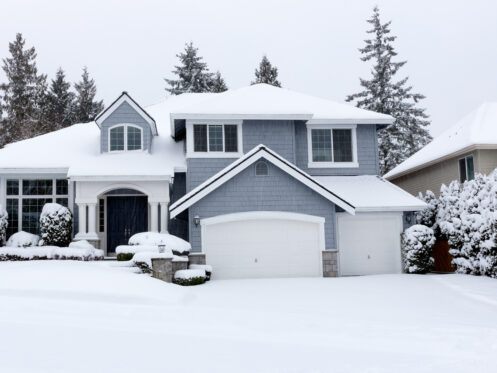Are you concerned about the effect of snow on your roof this winter? Snow and ice have the potential to damage your roof as well as your gutters. Your roof could also collapse if too much snow accumulates, so you must understand how much snow your roof can support.
Maximum Snow Amount for Residential Roofs
Most homes have sloped roofs that can support much more weight than a flat roof. Most sloped roofs are strong enough to keep up to 20 pounds per cubic foot.
Exactly how much snow this corresponds to depends on the type of snow and how wet it is. If the snow is fresh, light, and powdery, it typically takes three or four feet of accumulation to equal 20 pounds per cubic foot.
Old, packed snow or fresh, wet snow usually weighs about twice as much as powdery snow, meaning your roof may only support two feet. If there is already old snow on your roof and it starts snowing again, your roof may be able to keep two or three feet total, depending on how wet the new snow is.
It is essential to understand that these numbers are just averages, and some roofs can support much more weight than others. We recommend having your roof cleaned off any time there is more than 1-1.5 feet of snow just to be safe and reduce the risk of it collapsing or suffering significant damage.
How Much Ice Can a Roof Support?
Ice is always the biggest threat to your roof since it weighs far more than snow. In most cases, your roof can only safely handle around one inch of ice. You must take steps to prevent ice dams from forming on your roof.
The best way to avoid ice dams forming is to ensure that your attic is sufficiently insulated. If your attic floor is poorly insulated, lots more heat will rise into the attic. This results in the roof being much warmer, which causes the bottom layer of snow to melt and leads to ice dams forming.
How the Style and Condition of Your Roof Can Impact How Much Snow It Can Hold
Roofs with a steeper pitch are stronger and can support more weight than a roof with a lower pitch. Homes in much snowier climates typically have steeper roofs than in drier, less snowy climates. Another advantage of having a roof with a steep slope is that snow will slide off more quickly and not accumulate on your roof as much.
The type of roofing material your home has can also impact how much weight it can support and how much snow it can handle. Metal roofs can usually keep the most weight, and this is simply because metal roof sheets weigh about half as much as shingles. Another advantage of metal roofing is that the snow will easily slide off the roof, especially as it melts.
One of the most essential factors in how much snow your roof can hold is its condition. If your roof is old and in poor condition, it can only support a little weight. Any parts of your roof that have started to sag are also at much greater risk of collapsing if too much snow accumulates on the roof.
If your shingles are old and your roof leaks, it will also be more prone to collapsing due to snow. Leaks can damage the wooden sheets underneath the roof or the roof trusses and cause the wood to rot. If you live in a snowier place, it’s always a good idea to have your roof professionally inspected before winter to ensure it is in good shape and is capable of supporting more weight.
If you’re worried about your roof holding up this winter, you can count on Jimmy's Roofing for help. We specialize in residential and commercial roof inspections, roofing repairs, and maintenance. If your roof needs to be in better shape, we also offer professional roof replacement services in the Spokane, Portland, Seattle, and Coeur d’Alene areas. We provide financing options for those who qualify to help you manage the cost of a new system through Service Finance Company, LLC, or GreenSky. Call us to schedule an inspection and ensure your roof is ready for winter.



 #thejimmysWAY
#thejimmysWAY